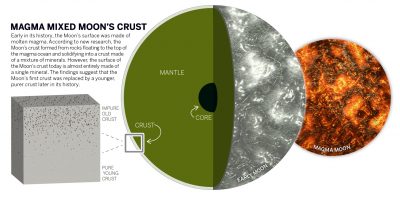Moon’s Crust Underwent Resurfacing After Forming From Magma Ocean
November 28, 2017
 The Earth’s Moon had a rough start in life. Formed from a chunk of the Earth that was lopped off during a planetary collision, it spent its early years covered by a roiling global ocean of molten magma before cooling and forming the serene surface we know today.
The Earth’s Moon had a rough start in life. Formed from a chunk of the Earth that was lopped off during a planetary collision, it spent its early years covered by a roiling global ocean of molten magma before cooling and forming the serene surface we know today.
A research team led by The University of Texas at Austin Jackson School of Geosciences took to the lab to recreate the magmatic melt that once formed the lunar surface and uncovered new insights on how the modern moonscape came to be. Their study shows that the Moon’s crust initially formed from rock floating to the surface of the magma ocean and cooling. However, the team also found that one of the great mysteries of the lunar body’s formation – how it could develop a crust composed of just one mineral – cannot be explained by the initial crust formation and must have been the result of some secondary event.
Astrobiology Magazine, Nov.26, 2017
International Business Times, Nov.23, 2017
Tennessee Today, Nov.22, 2017
AGU Blogosphere, Nov. 22, 2017
Featuring: Nick Dygert, former postdoctoral researcher, Department of Geological Sciences, Jackson School of Geosciences
